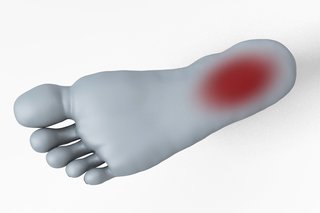What Can I Take for Plantar Fasciitis
Plantar fasciitis is where you have pain on the bottom of your foot, around your heel and arch. You can usually ease the pain yourself, but see a GP if the pain does not improve within 2 weeks.
Check if you have plantar fasciitis

It's more likely to be plantar fasciitis if:
- the pain is much worse when you start walking after sleeping or resting
- the pain feels better during exercise, but returns after resting
- it's difficult to raise your toes off the floor
How to ease plantar fasciitis yourself
If you see a GP, they'll usually suggest you try these things:
Do
-
rest and raise your foot on a stool when you can
-
put an ice pack (or bag of frozen peas) in a towel on the painful area for up to 20 minutes every 2 to 3 hours
-
wear wide comfortable shoes with a low heel and soft sole
-
use soft insoles or heel pads in your shoes
-
regular gentle stretching exercises
-
exercises that do not put pressure on your feet, such as swimming
-
take paracetamol
Don't
-
do not take ibuprofen for the first 48 hours
-
do not walk or stand for long periods
-
do not wear high heels or tight pointy shoes
-
do not wear flip-flops or backless slippers
-
try not to walk barefoot on hard surfaces
You can ask a pharmacist about:
- the best painkiller to take
- insoles and pads for your shoes
- if you need to see a GP
Find a pharmacy
Non-urgent advice: See a GP if:
- the pain is severe or stopping you doing normal activities
- the pain is getting worse or keeps coming back
- the pain has not improved after treating it yourself for 2 weeks
- you have any tingling or loss of feeling in your foot
- you have diabetes – foot problems can be more serious if you have diabetes
What we mean by severe pain
- Severe pain:
-
- always there and so bad it's hard to think or talk
- you cannot sleep
- it's very hard to move, get out of bed, go to the bathroom, wash or dress
- Moderate pain:
-
- always there
- makes it hard to concentrate or sleep
- you can manage to get up, wash or dress
- Mild pain:
-
- comes and goes
- is annoying but does not stop you doing things like going to work
Information:
Coronavirus (COVID-19) update: how to contact a GP
It's still important to get help from a GP if you need it. To contact your GP surgery:
- visit their website
- use the NHS App
- call them
Find out about using the NHS during COVID-19
Treatment for plantar fasciitis from a foot specialist
A GP might refer you to a physiotherapist for exercises or to see a foot specialist (podiatrist), who can recommend things like insoles and the right shoes to wear.
Physiotherapy is available free of charge on the NHS throughout the UK but waiting times can sometimes be long. Depending on where you live, you may be able to self-refer or you may need to visit a GP or consultant first.
Read more about accessing physiotherapy.
Podiatry may not be available for free on the NHS everywhere and waiting times can sometimes be long.
You can also pay to see a podiatrist or physiotherapist privately.
Find a registered podiatrist
Find a registered physiotherapist
Common causes of plantar fasciitis
Plantar fasciitis is caused by straining the part of your foot that connects your heel bone to your toes (plantar fascia).
It's not always clear why this happens.
You may be more likely to get plantar fasciitis if you:
- recently started exercising on hard surfaces
- exercise with a tight calf or heel
- overstretch the sole of your foot during exercise
- recently started doing a lot more walking, running or standing up
- wear shoes with poor cushioning or support
- are very overweight
Page last reviewed: 01 April 2019
Next review due: 01 April 2022
What Can I Take for Plantar Fasciitis
Source: https://www.nhs.uk/conditions/plantar-fasciitis/
0 Response to "What Can I Take for Plantar Fasciitis"
Post a Comment